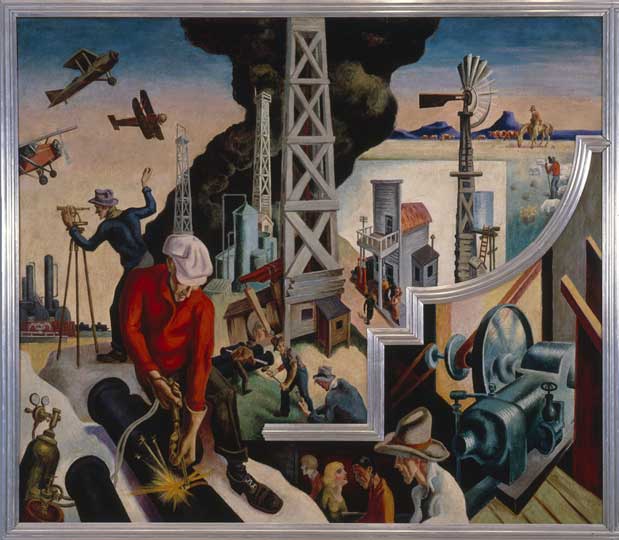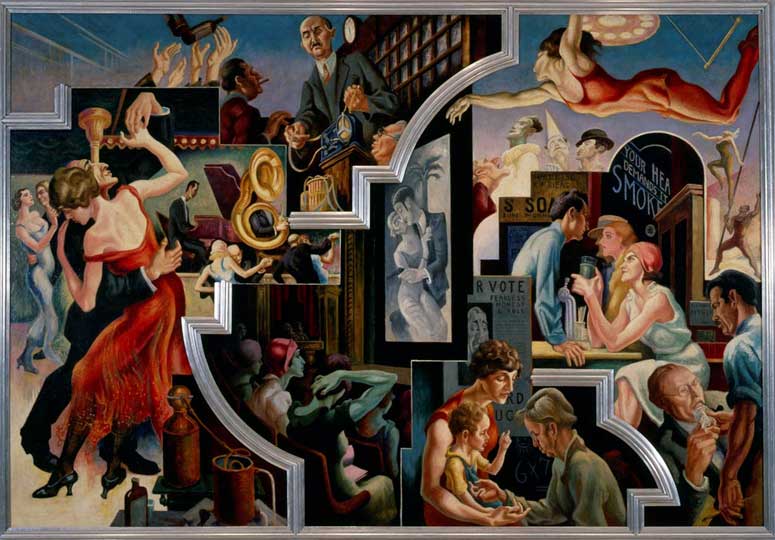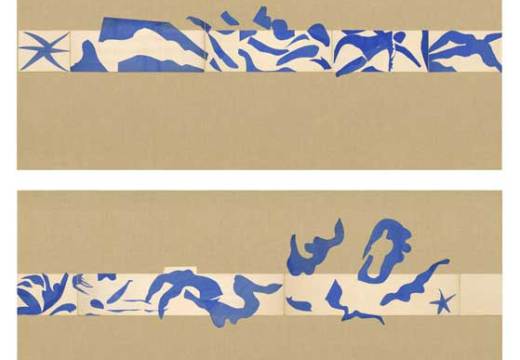‘I don’t know whether it’s art or not, and I don’t care’, wrote Thomas Hart Benton in 1931 of his just-completed mural series ‘America Today’. They filled the boardroom walls of the daringly progressive New School for Social Research in downtown Manhattan, founded in 1919 to address ‘the intellectual timidity of traditional colleges’. ‘What I wanted was to show the energy and rush and confusion of American life.’ And he did.
Now, all 10 murals go on show at the Metropolitan Museum of Art in a replica gallery, the latest period room to open in the enlightening American Wing. Surrounded by an exhibition about Benton’s contemporaries, his pupils (who included Jackson Pollock) and work related to the commission – plus a documentary film about the murals’ own story – it is a gem of a show.

Changing West (from ‘America Today’; 1930–31), Thomas Hart Benton. The Metropolitan Museum of Art, Gift of AXA Equitable, 2012
Benton (1889–1975) was born into a high profile political family in Missouri but rejected his father’s plans for a political career and, supported by his mother, enrolled at the Art Institute of Chicago. After a sojourn in Paris, where he met the great Mexican muralist Diego Rivera, he returned to the US where he served in the US Navy during the First World War and made drawings documenting shipyard work and life. All of this played into his future career.
From 1926 to 1935, Benton taught at the Art Students League of New York where his most notable student was Pollock (who later credited Benton with giving him something to rebel against). Benton stuck firmly to his naturalist and representational work, rejecting the modernism introduced at New York’s 1913 Armory Show in favour of the Regionalists. The exhibition’s first gallery sets him in this context with works by Reginald Marsh, Dorothea Lange, Stuart Davis, John Steuart Curry, and others.
Declaring himself ‘an enemy of modernism’, it was surely Benton’s progressive political views rather than his artistic daring that won him his first major commission, to decorate the board room of the New School’s radical International Style building designed by Joseph Urban. The paintings give a panoramic sweep across the US on the eve of the Great Depression, a land Benton called ‘loud and not in good taste’.
They overflow with all the sensuality, energy, over-consumption, over-production, excitement, power and grubbiness of America in 1930–31. Yet, after the big bold scenes of subways in New York, steam trains splicing through the Mid-West, and industry emerging across the country, all peopled with Benton’s hero labourers working, travelling, playing, drinking and flirting, the murals end on a sombre note: a group of desperate hands reaching up for coffee and bread, acknowledging the long economic depression ahead. One can only speculate on their impact as a background to New School board meetings.

Outreaching Hands (from ‘America Today’; 1930–31), Thomas Hart Benton. The Metropolitan Museum of Art, Gift of AXA Equitable, 2012
After more than 50 years there the murals were put up for sale, almost divided up, and saved in 1984 when Equitable Life (now AXA) bought them for their new building on Seventh Avenue. There, New Yorkers enjoyed them on display in their lobby. In 2012, AXA gave them to the Met. As the Met’s director Thomas P. Campbell recognised when he first saw the series: ‘It connects America’s early 20th-century art all the way through to the Abstract Expressionists…[Today] we see it with fresh eyes, there are themes and ideas that are more relevant to today than ever before.’
It also seems to be part of America’s rediscovery of its Regionalist and associated painters this year (see Apollo’s reviews of Marsden Hartley and Charles E Burchfield shows), artists who, as Campbell says, have been ‘victims of the whims of taste’.
‘Thomas Hart Benton’s America Today Mural Rediscovered’ is at the Metropolitan Museum of Art, New York, until 19 April 2015. To put the murals in context, a short walk away the Met has hung a string of galleries with its American paintings of 1900–1940.
Unlimited access from just $16 every 3 months
Subscribe to get unlimited and exclusive access to the top art stories, interviews and exhibition reviews.














![Masterpiece [Re]discovery 2022. Photo: Ben Fisher Photography, courtesy of Masterpiece London](http://www.apollo-magazine.com/wp-content/uploads/2022/07/MPL2022_4263.jpg)
Why are fathers so absent from art history?